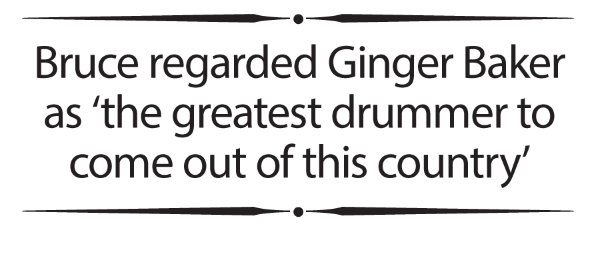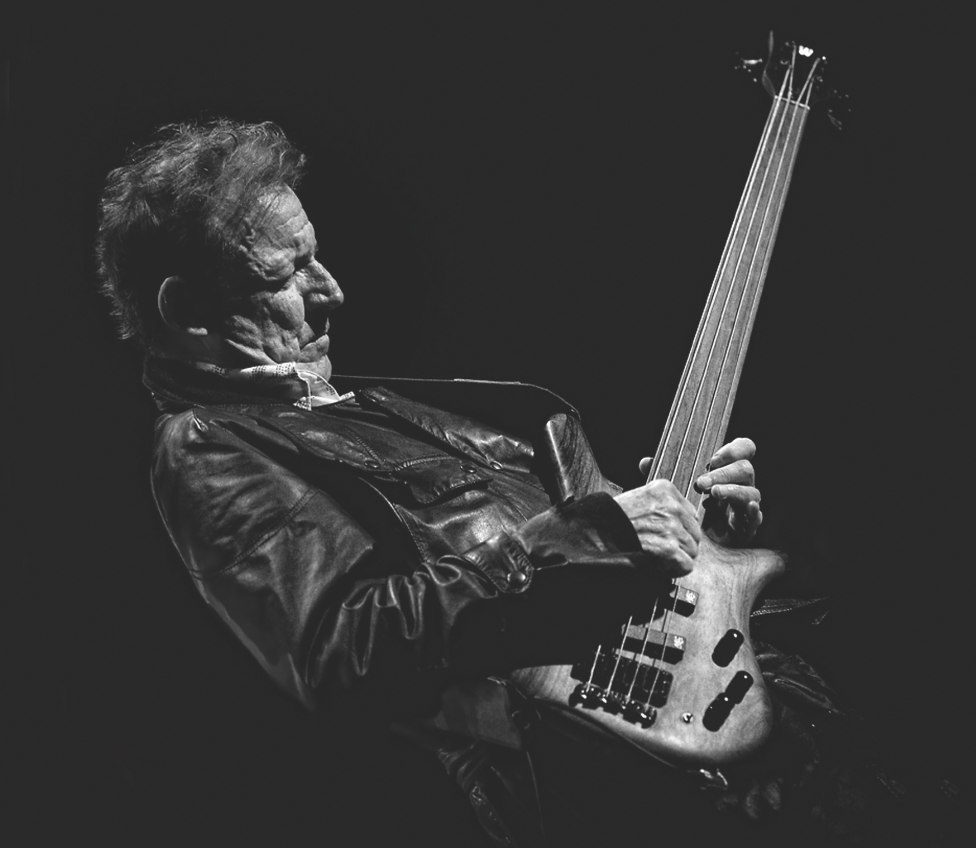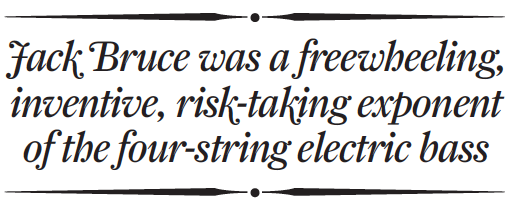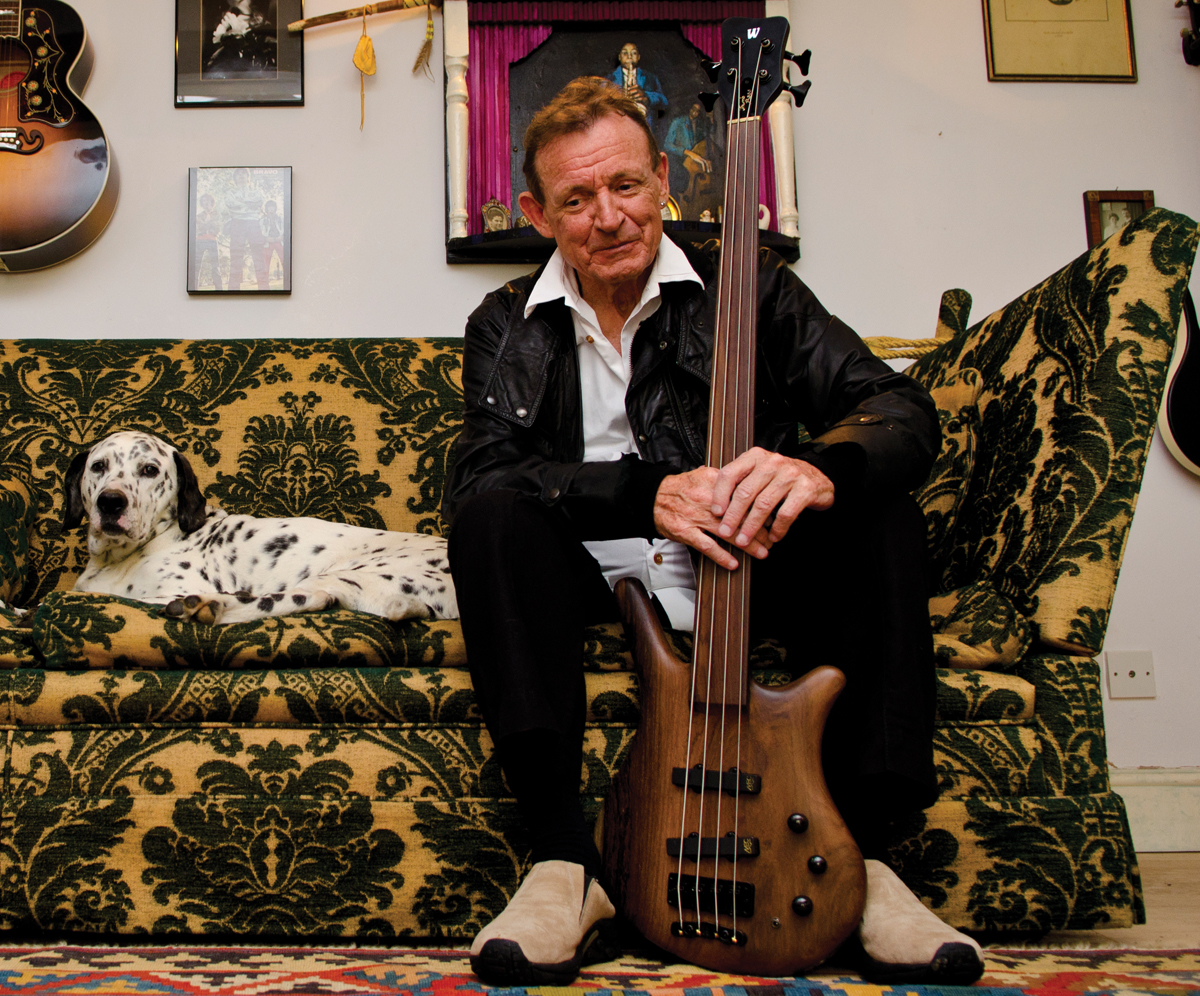Jack Bruce Retrospective – Captain Jack
Bassist, singer and songwriter Jack Bruce carved a unique swathe though music for over five decades. Gareth Morgan pays tribute

When we lost Jack Bruce on the 25th October, 2014, to liver disease, we lost the pre-eminent rock bass player of his generation, regarded by Jeff Berlin as ‘the first electric bass virtuoso’ and by Pink Floyd’s Roger Waters as ‘probably the most musically gifted bass player who’s ever been’.
The esteem in which Bruce is held springs primarily from his groundbreaking bass work with legendary supergroup Cream, alongside drummer Ginger Baker and Eric Clapton, but was also fuelled by a succession of fine solo albums and gigs with luminaries including Frank Zappa, ex-Miles Davis drummer Tony Williams, and guitarist John McLaughlin’s Mahavishnu Orchestra.
Just as James Jamerson is afforded legendary status for his expressive and melodically adventurous grooves on classic Motown from the mid-late ’60s, lines that created the template for modern funk bass playing, and Paul McCartney gets his membership to the club for his genius in showing us that melodic basslines can be as essential an element in pop music as the feted chorus hook, Jack Bruce is there too.
Though he virtually defined creative bass playing in the rock genre, it wasn’t just a question of chops – although you only have to listen to Cream live recordings (Crossroads on the Wheels Of Fire album being one example) to see how he was fertilising the genre with radical ideas.
With Cream and on early solo albums Bruce’s sound was a snorting, snarling monster, delivered on a short-scale Gibson EB-3 and often fuelled by a battery of Marshall stacks juiced up to 11, an unusually (for the time) extreme approach to sound shaping which imbued his tone with rich valve distortion, the end result being something akin to an over-driven tuba.
Many tried in vain to reproduce the majesty of this sound, but it wasn’t all about extreme volume and distortion but rather a chocolatey combination of a huge bottom end, a singing midrange and clear highs with none of the hi-fi ‘click’ that can be such a negative element in the modern bass tone. Bruce used conventional fingerstyle technique, and his initial schooling on upright bass meant there was plenty of weight in his playing stroke – another important factor in his signature sound.
Even though it’s not our true focus here, it has to be said that Jack Bruce was also a truly fabulous singer and equally talented songwriter, mainly in partnership with lyricist/poet Pete Brown, a fruitful union that lasted almost 50 years, in the process spawning the majority of classic songs originally recorded by Cream.
Bruce used his voice intelligently and with great subtlety on Cream’s studio recordings and the band’s readiness to embrace a variety of styles allowed him to experiment with a beautiful falsetto on songs like We’re Going Wrong (Disraeli Gears), a sleazy blues drawl on Sleepy Time Time (Fresh Cream), and a to the solid, powerful higher middle-register rock voice on White Room (Wheels Of Fire). Much of the studio subtleties were lost when Cream walked out on stage; listen to how on White Room Bruce replaced his wispy falsetto in the chorus with a full-throated wail, which was equally effective in a very different way.
Completing the package, Bruce’s enquiring mind and unquenchable appetite for exploring new musical frontiers guaranteed that the songs he wrote and the way he played never settled into a comfortable niche. The music he created continually evolved through the course of his solo career, a career that spawned 14 albums from Songs For A Tailor in 1969 to Silver Rails, his latest offering, released in early 2014, which sadly proved to be his last.
Jack Bruce was born John Symon Asher Bruce in Bishopbriggs, Lanarkshire, Scotland, on 14 May 1943. His first instrument was cello and by the time he picked up a double bass aged 16, he’d already become interested in jazz, fuelled by the enthusiasm of his dad Charlie and his brother Jimmy.
He listened and marvelled at Ray Brown’s solid work with Oscar Peterson and at the Modern Jazz Quartet’s Percy Heath, who Bruce described as ‘the first person I really heard playing amazing bass’. Whilst attending the Bellahouston Academy in Glasgow in 1958 he won a scholarship to study music part-time at the Royal Scottish Academy of Music & Drama, but the classical basis of the curriculum was a mis-match with Bruce’s developing free-spirit approach. He wanted to be ‘more cutting-edge, more esoteric’, and he wanted to play jazz. Still, he was happy to accept any gig, provided it paid a wage. His first, with ballroom circuit specialists the Freddie Riley Trio, paid £10 per show, which equates to £200 in today’s terms.
Whilst attending the Bellahouston Academy in Glasgow in 1958 he won a scholarship to study music part-time at the Royal Scottish Academy of Music & Drama, but the classical basis of the curriculum was a mis-match with Bruce’s developing free-spirit approach. He wanted to be ‘more cutting-edge, more esoteric’, and he wanted to play jazz. Still, he was happy to accept any gig, provided it paid a wage. His first, with ballroom circuit specialists the Freddie Riley Trio, paid £10 per show, which equates to £200 in today’s terms.
At the age of 18 his facility on bass was fully appreciated by those in Glasgow, but Bruce knew he needed to be in London. In 1962, after a stint in Italy with the Maynard Ferguson-inspired Murray Campbell Big Band (for his audition he impressively sight-read a transcription of Ray Brown’s solo on One Bass Hit) and a stint on the sidelines recovering from being badly burnt in an incident with a Zippo lighter, Bruce relocated to London and a gig with Alexis Korner’s Blues Incorporated and his first rhythm section hook-up with Ginger Baker.
The following year Bruce and Baker were a section in The Graham Bond Quartet, featuring John McLaughlin, renamed Organisation upon McLaughlin’s departure in early 1964. Bruce switched to electric bass, initially a Fender Bass VI, to compensate for the lack of guitar, supplemented later by a Danelectro Longhorn and a Gibson EB-3. Around this time, Bruce discovered he could sing; however, the well-documented ‘difficulties’ with Baker first surfaced. The combination of Baker’s fiery character and short fuse with Bruce’s love of pranks and equally volcanic temper, fuelled by both men’s highly competitive nature, ensured that the course of their relationship would always undulate significantly.
Around this time, Bruce discovered he could sing; however, the well-documented ‘difficulties’ with Baker first surfaced. The combination of Baker’s fiery character and short fuse with Bruce’s love of pranks and equally volcanic temper, fuelled by both men’s highly competitive nature, ensured that the course of their relationship would always undulate significantly.
Baker gradually took control of the band and fired Bruce, even threatening him with a knife when Bruce continued to turn up for gigs (he had married in 1964, and needed the money). Unemployment was not a state that Bruce’s talent permitted to exist for long, and stints followed with John Mayall’s Bluesbreakers (where he first encountered Clapton), and Manfred Mann.
Then the telephone rang with an unexpected caller. It was Baker, asking if he’d be interested in forming a band with Clapton. Bruce had no hesitation in accepting; after all, he regarded Baker as ‘the greatest drummer to come out of this country without a doubt’, and part of a bass player’s raison d’etre is playing with a good drummer.
In late 1966 came Cream’s first album, Fresh Cream, and their second single and first notable hit, I Feel Free. By the time of the second album, Disraeli Gears, the largely blues- and covers-based material had been augmented by intelligently-written rock songs, some with distinct psychedelic overtones. It spawned three hits, including Sunshine Of Your Love, and promoted the band to the big league in the US, where Cream’s famous improvised jams were most enthusiastically received (the almost three-minute N.S.U. was regularly well over three times that length live).
These extended sections were also part of the reason for Cream’s demise, as the band rapidly tired of them but felt forced to live up to expectations. Add to this exhaustion engendered by the relentless gigging schedule and the resurgence of hostility in the rhythm section, and you can understand why band relations became strained beyond breaking point. By the time Wheels Of Fire – a one studio/one live disc double album featuring accepted classics White Room and Crossroads, the former penned by Bruce and Brown – surfaced in July ’68, they had decided to stop. A final studio album in early ’69 (Goodbye) was followed by a farewell tour, with the second show at the Albert Hall on 26 November, 1969, being Cream’s last.
Bruce immediately embarked on a solo career, having already recorded the straight-ahead jazz album, Things We Like, featuring McLaughlin on guitar, in 1968. Delayed until December 1970, it appeared more than a year later than Songs For A Tailor, an underrated set packed with Bruce/Brown classics including Theme From An Imaginary Western. His distorted EB-3 playing demanded attention, while the storming funk on The Ministry Of Bag was a notable highlight.
Three further studio albums appeared in the ’70s, Harmony Row (1971), Out Of The Storm (1974) and How’s Tricks (1977), with Jet Set Jewel, recorded in 1978, held over until 2003, and Bruce is in good form on each. He was continually nudging boundaries between various styles in his compositions, often resulting in sophisticated songs with real emotional weight.
During this period, Bruce worked with Frank Zappa and in drummer Tony Williams’ Lifetime, recorded three albums with ex-Mountain guitarist Leslie West and drummer Corky Laing, played bass on the Berlin album by Lou Reed, and toured with the Mahavishnu Orchestra. Yet throughout this period of joyous creation, making the music he wanted to make and then some, Bruce was in serious and ever-deepening trouble.
He had become addicted to heroin in 1971, and it stalked him throughout the 1970s and much of the ’80s; he also became embroiled in royalty disputes with RSO, the company founded by former Cream manager Robert Stigwood. It took him until 1986 to get control over his addiction, aided by specialist treatment, which is a testament to his strength of will and the support he received from his second wife, Margrit.
Three albums appeared through this decade (Somethin Els, recorded 1987, wasn’t released for six years), with Bruce enjoying the rhythm section company of fusion drummer Billy Cobham and also enduring a brief reunion with Baker, sparring with guitarists Clem Clempson and Vernon Reid, whilst his health slowly stabilised at the end of the decade.
His choice of instrument had also gone through changes during this period, initially settling on an Aria SB-1000 via experiments with a Hohner fretless, Spector and Wal basses, but the chance discovery of a Warwick in a small German music shop in the early ’80s led him to a Thumb Bass fretless, whose modern form is at least partly due to Bruce’s advice and suggestions. It remained his main axe for the remainder of his career.
Musically, there was a pause in Bruce’s output – save for the duo offering Monkjack (1995) with Funkadelic keyboardist Bernie Worrell – between 1990’s A Question Of Time and Shadows In The Air from 2001, largely because he spent much of the decade in less stressful sideman mode with Ringo Starr’s All-Starr Band, but both albums carried evidence that Bruce was far from a spent force, and More Jack Than God, released 2003, further confirmed this.
But, that same year his past life caught up with Bruce again – the years of heroin addiction and heavy alcohol consumption contributed to cirrhosis of the liver which, in turn, became inoperably cancerous. Bruce received a transplant in October 2003; his body initially rejected the new organ, but he was eventually able to make an excellent recovery. This was quite handy for the millions of people round the world hoping, even praying that one day Cream would reform. All their wishes were granted on May 2, 2005, when the three musketeers walked out on to the stage at the Albert Hall, just under 36 years after leaving it as Cream for the last time.
This was quite handy for the millions of people round the world hoping, even praying that one day Cream would reform. All their wishes were granted on May 2, 2005, when the three musketeers walked out on to the stage at the Albert Hall, just under 36 years after leaving it as Cream for the last time.
 As it turned out, the concerts were not an attempt at a carbon copy, and that included the equipment used; according to Bruce, ‘Eric and I did try using the gear we had in the ‘60s, but it sounded terrible, so we had some fun and went back to our modern gear.’
As it turned out, the concerts were not an attempt at a carbon copy, and that included the equipment used; according to Bruce, ‘Eric and I did try using the gear we had in the ‘60s, but it sounded terrible, so we had some fun and went back to our modern gear.’
While the improvisational spirit that was a core element of the band was retained, the trio were careful to apply taste and discretion, even conservatism in approaching the songs. Watch the DVD and you get the impression all three are enjoying the nostalgia of the occasion and feeding off the sheer joy of playing as Cream again. Bruce, still very much in recovery, sang and played with passion, and sounded especially good on an old violin-shaped Gibson EB-1.
Prior to his last solo album, Bruce recorded two with old sparring partner, guitarist Robin Trower (Seven Moons and Seven Moons Live in 2008 and 2009) and one interesting collaboration with Vernon Reid, drummer Cindy Blackman Santana and keyboardist John Medeski (Spectrum Road, 2012). The Cream reunion had not only refreshed his finances, it had re-ignited his love of playing music. This was no better highlighted than by the quality of the final album, Silver Rails, which is widely regarded as one of Bruce’s strongest efforts and probably his best overall in years.
On 25th October, we lost a freewheeling, inventive, risk-taking, one-of-a-kind exponent of the four-string electric bass, a bassist who broke rules, widening the horizon for the instrument in the process. There’s only one thing to do: go check out Cream Live Volume I and II or Wheels Of Fire’s live tracks, or the album Spirit: Live At The BBC 1971-1978, sit back, close your eyes and imagine this diminutive shaggy-haired Scot, tearing the proverbial out of it on a cherry red Gibson EB-3. You’ll be smiling in seconds. Thanks for everything, Jack
